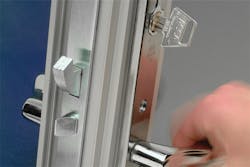How do we define “builders hardware”? Builder’s hardware as a category of building products refers to products that are mounted onto the moving parts of buildings, such as doors, in order to move, fasten or protect them. Generally, and usually in the case of the Builders Hardware Manufacturers Association (BHMA), builders hardware will refer to a commercial context.
This is not a definition likely to change anytime soon. When new products come along such as electrified hardware, they can be added in instead of needing their own definition.
Grouping the hardware that is used around doors and windows together is the logical way to do it, and is the approach BHMA/ANSI Standards for building hardware endorse.
BHMA is the nationally leading trade association for the builders hardware manufacturing industry. BHMA is composed of U.S. manufacturers of builders hardware in categories such as cabinet hardware and hinges, sliding and folding door hardware, and power doors and components.
BHMA is the only U.S. organization which through the American National Standards Institute (ANSI) creates standards for builder’s hardware. ANSI/BHMA Standards are the written criteria which define the appropriate operation, test values and safety criteria of builders hardware products. In addition to ensuring hardware quality and performance through its development of standards, BHMA also sponsors third-party certification of hardware products.
BHMA’s approach to curating hardware into each standard tries to keep definitions simple but inclusive, without getting overly broad and unwieldy. A product which performs a new function generally will need a new standard; but even a radical innovation of an existing technology can most likely be properly placed in an existing Standard.
How is builders hardware developed into the standard?
BHMA Standards are approved by and accredited through ANSI. ANSI stipulates that standards must be updated every 5 years. BHMA starts the process of updating each Standard again every three or four years so that there is time to get it approved by the five-year deadline.
When Standards are updated, new innovations or technology for a particular piece of hardware are reflected in the updated standard to be approved.
For example, let’s examine the Cylinder Standard. New advancements in the application of mechatronic cylinders hitting the market led to the Cylinder Standard being updated ahead of schedule. These innovations were applied to and updated under the existing Standard, instead of having their own standard created particularly for mechatronic cylinders.
This way of updating Standards by adding new technology under the umbrella of an existing Standard is possible because the Standards set a bar for performance and not necessarily for design.
Standards are created as performance based standards; they are not prescriptive. Manufacturers are under no obligation to design their products in any specific ways but they must be able to meet the level of performance required by the Standards if they want certification.
This method of updating Standards is also reflected in the fact that BHMA wants all possible builders hardware to be covered by the Standards.
Standards are intended to be comprehensive. Ten new Standards have been introduced in the last 10 years. If something is currently not covered, it will get a new Standard eventually.
A Standard for multi-point locks is currently under development. If it is the next approved Standard, it will be Standard A 156.37. The higher standard number reflects its later development, as the Standards are listed in their order of creation.
When the Standards were first being created, six groups of product hardware were in the initial batch. These first six were the most essential parts of door hardware and include:
- A 156.1 Butts and Hinges
- A 156.2 Bored and Preassembled Locks and Latches
- A 156.3 Exit Devices
- A 156.4 Door Controls - Closers
- A 156.5 Auxiliary Locks and Cylinders
- A 156.6 Architectural Door Trim
The order of all 33 Standards reflects the order in which the Standards were developed.
What is the scope of hardware covered by BHMA standards?
If a piece of hardware helps a door operate, then it is likely covered by BHMA Standards. The first six BHMA Standards and related to products are that are essential to doors.
However, BHMA Standards are applicable across a wide range of moving building products.
BHMA Standards touch on cabinet workings such as:
- A 156.9 Cabinet Hardware
- A 156.11 Cabinet Locks
BHMA Standards relate to electric technologies that are often used in doors or locks:
- A 156.10 Power Operated Pedestrian Doors
- A 156.23 Electromagnetic Locks
- A156.25 Electrified Locking Devices
Builders hardware does not just enable movement, but it can constrain movement as well; locks make up a considerable portion of BHMA Standards including:
- A 156.5 Auxiliary Locks and Associated Products
- A156.13 Mortise Locks
- A 156.24 Delayed Egress Locks
BHMA Standards for builders hardware have been created to ensure performance across the whole spectrum of builders hardware, and the professionals who rely on these Standards as well as the consumers who benefit from them are well served by their continued presence.






